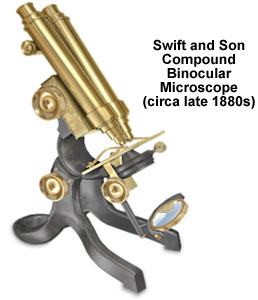Swift and Son Compound Binocular Microscope
Built sometime after 1895, the handsome black and brass compound, binocular microscope illustrated below is signed "J. Swift & Son, London, 14024 HY". The model featured below was redrawn from a photograph of the original microscope, which is part of the Billings microscope collection at Walter Reed Army Hospital in Washington, D.C.

The skilled British optical instrument makers at James Swift and Son designed the stunning, brass binocular microscope based on two Greenough-style stereoscopic tubes, each equipped with an objective and an eyepiece. Like other microscopes with similar optical configurations, the erect image of the specimen appears to be three-dimensional, but is inverted by 180 degrees. Enameled in black, the stand is a typical Swift combination upright and tripod base with flanges. The curved limb, which is fitted with grooves, moves in the flanges and is held in position with a large, milled-head brass screw, while the upper part of the limb forms an arm that has a double, milled-head pinion. At 3.75-square inches, the brass fixed stage is attached to the limb and includes a slide holder and a micrometer. The Swift binocular microscope is 13 inches high in its closed position, which makes it more convenient for storage and transport.
On the instrument illustrated above, the complete substage is mounted on a bar with a rack and pinion mechanism. A tubular bar, designed with a swinging motion and a sliding case and arm, suspends the gimbal-mounted, 2-inch double mirror below the substage. For coarse focusing, the 8-inch, dual brass body tubes feature a rack and pinion mechanism, which move in relation to the fixed stage. In order to achieve fine focus, a brass screw on the left side of the arm is employed (not illustrated). In the lower section of each Greenough stereoscopic tube, there is a prism box that is tipped by a cone-shaped nose. At the rear of each brass drawtube is another rack and pinion mechanism for controlled adjustments of the magnification by the microscopist.
BACK TO NINETEENTH CENTURY MICROSCOPES
